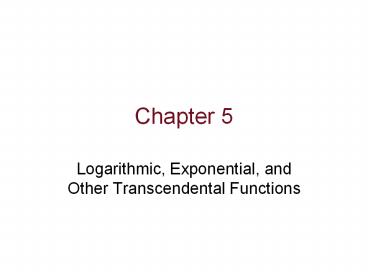Logarithmic, Exponential, and Other Transcendental Functions PowerPoint PPT Presentation
Title: Logarithmic, Exponential, and Other Transcendental Functions
1
Chapter 5
- Logarithmic, Exponential, and Other
Transcendental Functions
2
For x ? 0 and 0 ? a ? 1, y loga x if
and only if x a y. The function given by f (x)
loga x is called the logarithmic function with
base a.
Every logarithmic equation has an equivalent
exponential form y loga x is equivalent to x
a y
A logarithmic function is the inverse function of
an exponential function.
Exponential function y ax
Logarithmic function y logax is equivalent to
x ay
3
y ln x
The function defined by f(x) loge x ln x
is called the natural logarithm function.
In Calculus, we work almost exclusively with
natural logarithms!
4
Definition of the Natural Logarithmic Function
5
Theorem 5.1 Properties of the Natural Logarithmic
Function
6
Natural Log
7
Natural Log
Passes through (1,0) and (e,1).
You cant take the log of zero or a negative.
(Same graph 1 unit right)
8
Theorem 5.2 Logarithmic Properties
9
Properties of Natural Log
Expand
Write as a single log
10
Properties of Natural Log
Expand
Write as a single log
11
Definition of e
12
Theorem 5.3 Derivative of the Natural Logarithmic
Function
13
Derivative of Logarithmic Functions The
derivative is
Notice that the derivative of expressions such as
lnf(x) has no logarithm in the answer.
Example
Solution
14
Example
15
Example
16
Example
Product Rule
17
Example
18
Example
19
Example
20
Example
21
Theorem
22
Theorem
23
(No Transcript)
24
(No Transcript)
25
Theorem 5.4 Derivative Involving Absolute Value
26
(No Transcript)
27
Try Logarithmic Differentiation.
28
(No Transcript)
29
(No Transcript)
30
4. Show that is a
solution to the statement
.
31
4. Show that is a
solution to the statement
.
32
Find the equation of the line tangent to
at (1, 3)
At (1, 3) the slope of the tangent is 2
33
Find the equation of the tangent line to the
graph of the function
at the point (1, 6).
PowerShow.com is a leading presentation sharing website. It has millions of presentations already uploaded and available with 1,000s more being uploaded by its users every day. Whatever your area of interest, here you’ll be able to find and view presentations you’ll love and possibly download. And, best of all, it is completely free and easy to use.
You might even have a presentation you’d like to share with others. If so, just upload it to PowerShow.com. We’ll convert it to an HTML5 slideshow that includes all the media types you’ve already added: audio, video, music, pictures, animations and transition effects. Then you can share it with your target audience as well as PowerShow.com’s millions of monthly visitors. And, again, it’s all free.
About the Developers
PowerShow.com is brought to you by CrystalGraphics, the award-winning developer and market-leading publisher of rich-media enhancement products for presentations. Our product offerings include millions of PowerPoint templates, diagrams, animated 3D characters and more.

